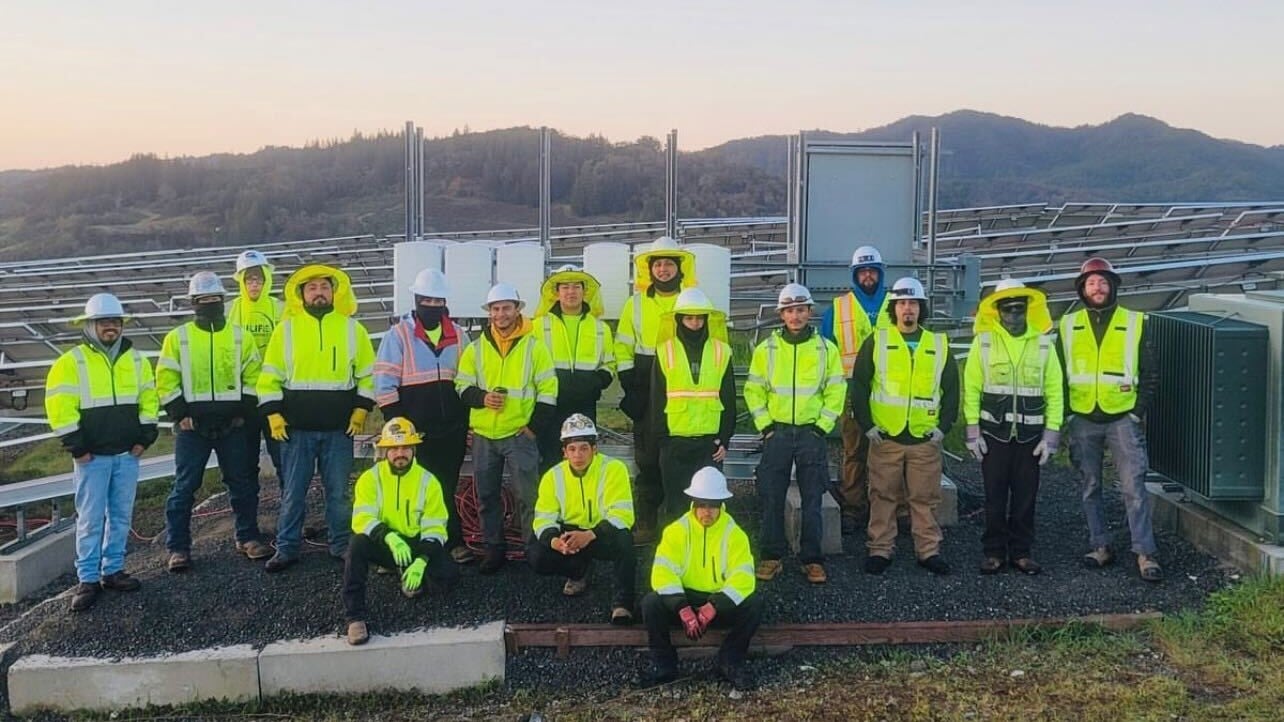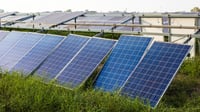Every day, you can find stories about new solar developments around the world in the trade news. Occasionally, you may stumble upon an article discussing the important topic of end-of-life solar management. These articles often emphasize the alarming issue of solar panel waste ending up in landfills. However, it’s less common to find an article like this one that delves into the innovative solutions and professionals leading the secondary solar market.
NuLife Power is a prominent player in this industry niche. If you haven’t heard of NuLife before, then allow us to introduce you. Founded in 2015 by Cesar Barbosa, who serves as the president & CEO, NuLife operates as a ‘Special Projects’ contractor. The company’s services include rooftop solar removal and reinstallation, medium- to large-corrective maintenance, solar PV decommissioning, and end-of-life management.
Since NuLife’s first decommissioning project in 2018, the company has completed over 20 commercial site projects, effectively diverting roughly 1,000 tons of solar waste from landfills and repurposing over 50,000 solar panels. Yet, what truly sets NuLife apart is its dedication to nurturing and cultivating the next generation of solar workers.
“To me, having a keen focus on workforce development is something that every solar organization should dedicate resources to, both for your own benefit as well as for the health of our industry,” says Saxon Metzger, Solar Project Development Manager. “NuLife creates stable careers for our employees with the security and peace of mind that they can provide for their families, perform meaningful work in the world, and enjoy a workplace that respects their unique value.”
We chatted with Saxon to learn more about NuLife’s innovative solar end-of-life services as well as how the company’s workforce development efforts produce efficient, happy, and healthy team members. NuLife joined EnergyBin in 2022.
EB: 'NuLife' is a unique name for a company. What's the meaning behind the name, and how does it reflect the company culture?
The name 'NuLife Power' reflects our company's mission and values, and was carefully chosen by our founder, a 14-year veteran in the solar industry. It symbolizes our unwavering commitment to renew and revitalize aging solar assets. These systems often require substantial corrective maintenance, retrofitting, repowering, and responsible end-of-life decommissioning to maintain their efficiency and environmental benefits.
At NuLife, our culture revolves around the concept of infusing new life into America's legacy commercial and utility solar systems. We are also deeply committed to developing a new generation of solar experts, addressing the infrastructure's needs as well as nurturing the skills and knowledge of those operating within it.
Our dedication remains steadfast, focused on extending the longevity and performance optimization of solar systems while simultaneously contributing to the creation of well-paying jobs in America.
EB: What's your role in the company, and what are you passionate about?
I’m the Solar Project Development Manager at NuLife, overseeing C&I repowering, remediation, removal and reinstallation, and decommissioning projects from outreach and marketing all the way through contract negotiation, and pre- and post-construction project management. I also direct our field operations for our portfolios of projects.
I’ve really come to appreciate working on solar end-of-life because it’s key to upholding the foundational promise of solar power as a truly sustainable and renewable option, not just a slightly slower way to burn through our planet's resources.
At NuLife, we have the capacity to invest in the care and management of all the legacy solar assets that have paved the way for our transition to clean energy. By following the basic principles of reduce, reuse, and recycle, we can prolong the environmental and economic benefits of these solar assets. To me, this work has special significance and has encouraged me to approach each project with creative solutions.
EB: NuLife has achieved some big milestones since its first decommissioning project in 2018, including the completion of over 20 commercial site projects, the diversion of approximately 1,000 tons of solar waste from landfills, and the repurposing of over 50,000 solar panels. What are the key ingredients to your success?
It’s really a commitment to learning and applying what we’ve learned that has made us successful. There are so few people in this decommissioning and repowering niche that it often feels like we’re learning and setting precedent all at the same time. We’ve come to understand that this isn’t just installation in reverse; it’s a completely different conversation with the client from start to finish and comes with unique challenges.
Working on legacy systems has taught me a few important lessons. First, this work has reinforced my profound respect for the generation of laborers that put together these millions of projects, one solar panel and ballast block at a time. And they’re doing it all while pioneering the construction and safety needed to support the promises of new technology and dreams of new industries.
Second, I’ve learned that solar end-of-life is a heavily labor-dependent project type since there’s no new material to install. Therefore, the biggest determinants of project cost and success by a longshot are based on the efficiency of your team. Building a solid team with experience is enhanced by the efficiency gained from each additional project the team works on. For example, you can apply the lessons you’ve learned on a specific racking removal to other projects that use that same brand of racking.
EB: What are the most common reasons that lead to a PV system decommissioning project?
The main reason folks decommission a system is because they legally must when a lease or PPA contract concludes. Another reason is the determination of a better use for the system project site. Age is a strong factor of decommissioning, correlated with how much degradation the site has experienced based on its setup, site conditions, and geographic locations.
But older doesn’t always mean sites are worse for wear, as a poorly installed site will lose production value and raise ongoing maintenance costs and repair requirements sooner than high quality installations. All these factors give rise to a replacement solar installation or repurposing the property to enhance economic value.
EB: Walk us through the decommissioning process for a typical commercial project. What steps are taken to get the job done, and what are the standard costs associated with such a project?
Our process starts with a free estimate, which can easily be initiated by accessing our end-of-life calculator on our website. The calculator is based on a 5-year compilation (2018-2023) of over a thousand data points to produce a low-medium-high pricing range. We’re excited to offer this tool to the solar industry, as it’s the first of its kind.
By entering a handful of project details, you’ll get a 2-page report with an estimated cost and description of the project within a couple days. The report breaks down the standard project costs by equipment, labor, material, recycling, etc. Once we’re able to discuss that quote in more detail and revise the estimate as needed based on preferences, we’d move onto scheduling the project and handling all the operations and logistics as a turnkey service.
EB: What has been the all-time oddest decommissioning job NuLife has faced? How did it challenge you, and what did you learn from it?
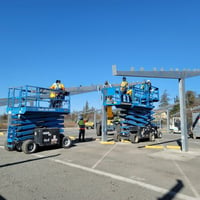 Recently, we decommissioned a carport system generating half a megawatt of power in a local municipal yard, with a requirement for prevailing wage compliance. This project involved a complete removal of the system down to the concrete footings, utilizing several large hydraulic breakers. It’s one of the first end-of-life solar projects in this county, which attracted the interest of prominent city officials who closely monitored the entire process from inception to completion.
Recently, we decommissioned a carport system generating half a megawatt of power in a local municipal yard, with a requirement for prevailing wage compliance. This project involved a complete removal of the system down to the concrete footings, utilizing several large hydraulic breakers. It’s one of the first end-of-life solar projects in this county, which attracted the interest of prominent city officials who closely monitored the entire process from inception to completion.
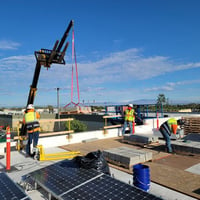 That reminds me of another unique endeavor where we removed approximately 7,000 rooftop panels from a cold storage warehouse located in the heart of Los Angeles. This complex task involved dealing with five distinct rooftops situated at varying levels. Moreover, we managed the recycling of over $120,000 worth of materials. I was so proud of the team for their exceptional coordination required to accomplish this feat.
That reminds me of another unique endeavor where we removed approximately 7,000 rooftop panels from a cold storage warehouse located in the heart of Los Angeles. This complex task involved dealing with five distinct rooftops situated at varying levels. Moreover, we managed the recycling of over $120,000 worth of materials. I was so proud of the team for their exceptional coordination required to accomplish this feat.
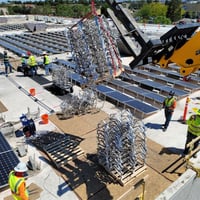 For me, these projects reflected the cutting edge of solar decommissioning. They led to incredible collaborative opportunities with EPC and O&M firms, recyclers, panel resellers, asset owners, permitting authorities, educational entities, and media outlets.
For me, these projects reflected the cutting edge of solar decommissioning. They led to incredible collaborative opportunities with EPC and O&M firms, recyclers, panel resellers, asset owners, permitting authorities, educational entities, and media outlets.
EB: Tell us more about how NuLife is pioneering the development of solar end-of-life special projects.
To give you an idea of the innovative position we’re in, whenever I approach the relevant permitting authorities for solar decommissioning or even repowering projects, it’s usually the first time that jurisdiction is faced with determining its official policies on solar end-of-life projects. My role is often twofold – as the project manager and as a subject expert.
Our experience in California and across the United States has shed light on the fact that while solar itself has become much more mainstream in the last two decades, few are talking about the reality of solar end-of-life. Our industry benefits from a grounded, realistic conversation based on facts and experience about what happens when a solar project begins to age out. When this conversation doesn’t take place, people tend to gravitate towards fearful concerns that panels will end up in landfills causing a massive waste nightmare. Now’s our opportunity to connect with people and let them know we’re taking care of it as an industry.
EB: On average, what percentage of decommissioned PV hardware would you say can be reused? What’s the process NuLife takes to prepare this equipment for resale?
It depends on the age and original quality of the module, but generally speaking, the vast majority can be reused. I’d estimate about 2-10% of modules on any given site have real damage that requires recycling. With that said, it’s challenging to find folks willing to take modules under 200-250 watts. These modules are around 15 years old, and the cost to ship them to another site across the country is high.
Inverters can sometimes be parted out, but it’s challenging to ship them and retain resale value. It can be expensive to recommission inverters, so they’re often recycled. The AC equipment of a solar system is usually able to be resold or at times left onsite for a new system, but it does have to be thoroughly inspected prior to reuse. Racking, wire, aluminum or metal raceways and hardware can all be recycled and credited back to the asset owner to offset the cost of decommissioning.
EB: Whare are used solar panels and components redeployed, and what applications are they repurposed for?
There are plenty of creative ways to reuse system components. We’ve donated panels to worthy causes in Central and South America and have received requests for module donations from non-profits worldwide. We regularly resell or reuse panels to repower sites or for service calls. But in order to safely reuse a module in an existing system, it needs to match the module size and electrical specifications. Additionally, some individuals will buy decommissioned solar material to utilize in DIY or off-grid systems as well.
EB: Several EnergyBin members are volume buyers of secondhand solar panels. What advice do you have for them to connect to secondhand supply as well as ensure they purchase quality modules that are safe for reuse?
Regarding supply, you’ll find it challenging to work out and arrange solar panel sales on the internet without a trustworthy exchange like EnergyBin or a trusted partner. Always expect a module per pallet to break no matter how carefully you stack, band, protect, and ship. Order accordingly. Also, keep in mind that logistics and transportation are costly. Be on the lookout for local buyers to reduce shipping costs.
EB: What tips do you have for EnergyBin members who are facing upcoming decommissioning projects?
Working on solar end-of-life projects like these has really taught me the value of detailed documentation and site walks. I’d say that it’s more common than not to discover that after ten or twenty years, the reality of the site no longer matches the original as-builts. Likely, the string map or the structural requirements of attachment points and/or ballast blocks have changed. It’s incredibly helpful to confirm project details with safety boots on the ground before launching into a major project. No one likes a change order after you’re already underway. The more information you can gather with photos, video, drone footage, and infrared technology, the better.
We’re always looking for partners in this work and opportunities to consult others to share our lessons learned. Feel free to reach out and see if we can share scope on any aspect of your project. We’ve partnered with O&M firms, installers and EPCs, roofers, and everyone in between and regularly meet and explain our scope to stakeholders of all types on a project, as many folks will need a bit more assistance working through and understanding this special type of bid compared to the normal bread and butter for solar firms.
EB: Beyond decommissioning services, in what other ways can NuLife help EnergyBin members with their solar goals?
We offer intensely trained and skilled field technicians as well as experience working on sites that require real consideration to determine optimal solutions. Projects that appear to be slated for decommissioning can at times be repowered or remediated through more affordable methods, and NuLife is a valuable resource for every aspect of what many firms are referring to as “Special Projects”.
Beyond this, we’re always available to provide on-site inspections to determine the extent of the damage to a particular system. This kind of initial service helps to determine critical factors for the actual scope of work, like what kinds of end-of-life options are available, specific project information to craft pricing for each option, and what hardware on-site is still viable.
In theory, there’s an average value expected from solar material that’s leftover. But until a thorough inspection takes place, it’d be premature to assume value. A detailed inspection, including photo and video proof, conducted by an experienced professional will provide the information needed to determine resale value as well as the integrity and usefulness of that material.
EB: Perhaps NuLife’s greatest ambition is to develop the next generation of solar workers. How does the company help employees become the best version of themselves?
We ensure that our crews go through regular personal and professional training with assigned leadership reading, mandatory OSHA 30 and equipment training schedules, and leadership seminars in-house.
Our field leadership team and field crew roster all have their OSHA 30. They attend daily and weekly safety briefings and are offered financial incentives to take additional training and courses through SEIA and other industry leaders.
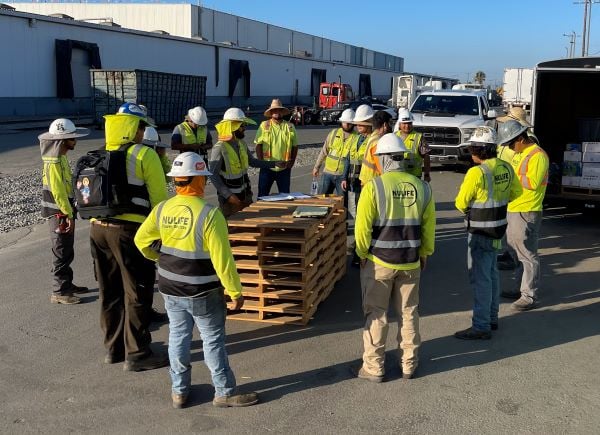
Furthermore, we focus on providing stable careers to our employees with the security and peace of mind that they can provide for their families, perform meaningful work in the world, and enjoy a workplace that respects the unique value of our blue-collar labor force.
EB: Regarding employee training, why go the extra mile?
We’re going the extra mile when it comes to workforce development because the fate of our industry depends on it. In the latest Solar Futures Study, the U.S. Department of Energy concludes that the industry will need as many as 500,000 to 1.5 million solar workers by 2035 in order to achieve ninety-five percent decarbonization of the electrical grid. While we recognize that sales pipelines are key to securing new solar deals, the reality is many of these jobs will rather be in the construction of the projects we’re selling.
To me, having a keen focus on workforce development is something that every solar organization should dedicate resources to, both for your own benefit as well as for the health of our industry. I’ve been the technician up on the roof and developer on the ground, so I understand the need for well-trained laborers across all aspects of the project workflow. I view my Solar Project Development Manager role as an authority I can hold only if I realize that I’m directly responsible for the safety and welfare of not just our field crew and leadership team, but to their families and dependents as well.
EB: EnergyBin members are committed to accelerating a robust and sustainable secondary market within the solar industry. Tell us about NuLife’s commitment to this mission, and where do you see your company 10 years from now?
We’re fully committed. We see ourselves playing a pivotal role in this endeavor by equipping our workforce with the skills and knowledge required to support the repowering and decommissioning phases of PV system lifecycles.
Ten years from now, we envision NuLife as a leading force in the sustainable transition of the solar industry, spearheading initiatives to efficiently manage the end-of-life phase of our customers’ PV systems.
EB: NuLife is an industry leader in providing secondary market solutions (decommissioning, removal, reinstallation, and repowering) as well as in developing the next generation of solar workers. In closing, what leadership advice do you have for your fellow PV professionals?
I think the best way to give leadership advice is by example. We hope to inspire PV professionals by the core values we operate under. We believe in the commitment to our mission, not just as a company but as a collective force within the solar industry. Extreme ownership is a principle we hold dear, taking responsibility for our actions and their consequences, ensuring accountability at every level. Integrity is the bedrock of our work, fostering trust and transparency in all our relationships. And we embrace continuous improvement as the key to staying at the forefront of the PV field.
Beyond these principles, my advice to peers in the solar industry is to embrace a set of core values that are meaningful to your company. Commit passionately to your mission. Take ownership of your work. Maintain unwavering integrity, and relentlessly pursue continuous improvement. In doing so, we can collectively shape a sustainable, innovative, and prosperous future for solar energy.
A special thanks...
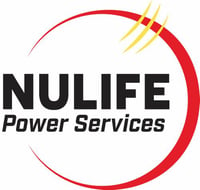
|
To Saxon Metzger for sharing how NuLife Power is innovating solar end-of-life special projects and developing the next generation of solar workers. |
